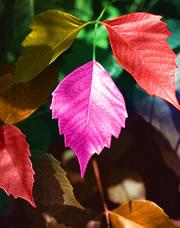 The local sunlight and atmosphere helps determine what colours a plant will absorb. See 'The colour of alien leaves'Getty
The local sunlight and atmosphere helps determine what colours a plant will absorb. See 'The colour of alien leaves'GettyA picnic on a far-flung planet orbiting a red dwarf might involve spreading your blanket on black grass and munching on purple veggies, according to a new model.
Given that we have yet to find bacteria, let alone little green men or purple palms, on any other planet, it might seem slightly ridiculous to spend time working out what colour plants elsewhere in the Universe must be. But scientists say that the thought experiment could be useful in helping us to look for lush landscapes in other solar systems.
Nancy Kiang, a biometeorologist at the NASA Goddard Institute for Space Studies in New York, modelled the solar and atmospheric conditions of other planets to see which ones might be suitable for photosynthetic life, and what those photosynthesizers might look like.
Red dwarfs, for example, emit only a fraction of the visible light produced by our own Sun, meaning that plants on planets around these stars will probably hoard all the visible light they can absorb, rather than reflecting back any particular wavelength, Kiang hypothesizes. That means they would probably look black.
Is there a colour that a plant couldn't be? Kiang thinks that it's unlikely that plants will be blue, no matter what planetary environs are out there.
It's not easy being green
Kiang isn't the first to wonder about such matters. H.G. Wells — unrestrained by the stifling predictions of atmospheric models — gave Mars a "vivid blood-red" kingdom of vegetables in his novel The War of the Worlds back in 1898.
Kiang and her colleagues took a more academic approach by surveying known photosynthetic systems on Earth to get a sense of the limitations that could constrain photosynthesis on other planets.1 Earth already provides a variety of colours and pigments to chose from — from the comforting greens of our land plants to the dull purples of some photosynthetic bacteria, and the jarring reds of certain seaweeds.
The colour reflected by each of these organisms is made up of the wavelengths that the photosynthesizer has shunned — typically those that are not particularly useful for them. The colour of a plant, therefore, can depend on the quality of light the plant receives and that, in turn, depends on the properties of the local sun and the atmosphere that filters out the sun's rays.
The sunlight that strikes Earth's surface, for example, is rich in green light, but land plants often shun this seemingly rich source of energy. Some researchers assumed that reflection of green light was the product of an evolutionary foible — just one of those cases in which the twisted path of evolution didn't yield the most efficient option. But green light is not as rich in photons as red light and not as energetic as blue light. So although plants seem to have wasted energy by not harnessing the abundant greens, Kiang thinks that they've just focused their efforts on the more nutritious reds and blues.
The team thinks that all plants will be keen to suck up high-energy blue light — so that rules out bright blue leaves. "In general, plants will want to use blue light if they can," says Victoria Meadows, an astronomer at the California Institute of Technology in Pasadena, California, and a collaborator on the study.
Blue planet
Kiang's results indicate that a broad range of solar systems, from hot F-class stars to the relatively dim M-class red dwarfs, should able to host planets with plant life in a range of colours2. "These planets could have a global-scale productivity [that is] comparable to that on Earth," says Kiang "That means that if you want to detect them by telescope, maybe there's enough there to see."
ADVERTISEMENT
Telescopes can't yet see the colours of far-flung rocky planets, but the team hopes that their work can be used to design instruments that can detect the spectral signatures characteristic of photosynthetic life. Their model helps to show which wavelengths plants on various planets would be most likely to absorb, creating a custom signature for life for different planetary situations.
Kiang's models are useful because they can help astronomers design their space telescopes with a search for photosynthetic life in mind, says astronomer Eric Ford from the Harvard-Smithsonian Center for Astrophysics in Cambridge, Massachusetts. To assume that photosynthetic organisms on other planets will abide by the rules on Earth is a bit of a stretch, but when the task before you is to predict what life will be like on other planets, you don't have a lot of options, he adds. "The reason we search is because we don't know," says Ford. "We really only have one data point so far, and clearly it's a biased data point."
Visit our plantsmaycomeinallc.html">newsblog to read and post comments about this story.
